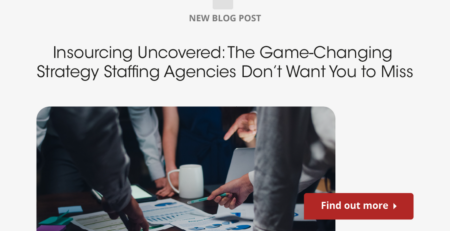What Creatives Need To Know About The Sales Cycle
Even for creatives, understanding how to make a product or service desirable is an essential skill. It might feel unnatural for those who haven’t specialized in sales and those who haven’t realized how much selling is already involved in creative work.
If you come up with a great idea for a new design, you have to sell it to stakeholders and fellow team members. When management asks the creative team to make complex business practices more palatable and comprehensible to their clientele, that’s a specific sales cycle.
Creatives don’t need to know all the ins and outs of selling any more than they have to understand everything about coding to make a great design. Still, some knowledge of the sales cycle steps will help creatives navigate the parts of their work that require a bit of salesmanship.
Keep reading to find out what creatives need to know about sales and what techniques are common to creative work and sales.
Sales 101 For Creatives
One of the reasons sales get a bad rap among creatives and many other professionals is because it seems pretty simple on its face. Find a product, talk about how great it is, get the sale or don’t, move on to the next target.
But that’s far from all there is to it. Sales are really a continuation of the company’s mission statement – the same one that designers and other creatives use as a framework when they’re working on a new project. Effective sales highlight what designers have put into a product or service to make it more enjoyable for the user.
Creatives who work in UX/UI design can think of sales staff as the medium for their creative ideas. The intentional features built into a project are going to be sales points later on. It’s all part of the same process.
Sales focus on created value most of the time. Any creative who has experience engaging with design thinking should be used to operating within this framework as well. It’s not about having the ‘best’ website, it’s about creating one that is easy to use and makes people’s lives easier.
UX/UI designers and other creatives using a design thinking approach begin with empathy but prospective clients don’t. Many businesses target them every day with marketing messages across different channels and they have no reason to pay attention to one in particular.
That’s where sales staff really shine. It’s not only important for a given brand’s messages to stand out against the competition, but also for it to resonate and create a meaningful connection with the people it reaches. Even if the product is great, all the creative work that went into it will be wasted without the right marketing.
When the creative work is directly related to advertising like it is with many marketing campaigns, creatives have a huge opportunity to continue forming the message that reaches prospective users. This generally creates a more cohesive message and better branding overall.
Sales are all about reaching out to people and demonstrating a deep knowledge of their problems before offering a solution. It’s easy to miss this mark – it happens all the time, just like ideas fail frequently throughout the creative process. It’s important to keep trying in both scenarios.

Sales Cycle Steps
Sales reps follow seven general steps to make a sale. They aren’t quite as interchangeable as design thinking steps, but they are iterative in a similar way.
Here are the seven sales cycle steps:
1. Find Leads
There’s no reason to begin the sales process totally uninformed. Generating leads and sales prospects will help target marketing efforts and get greater ROI on time and resources spent on advertising because more leads will be successful.
If you’re already familiar with the astronomic rise in the popularity of user data, then it won’t come as a surprise that this is one of the most common ways companies are generating leads for their sales staff. Not only do they understand more about the types of people who are likely to purchase their products, but they can make more informed guesses about when they’ll need the product again and what kind of marketing messages work best.
Other lead generation methods include cold calling, emailing, or mailing out flyers. Advertisements like billboards and social media posts aim to generate more leads as well. This search for leads is kind of like reaching out to find the real people that inspire the personas used in UX design.
2. Qualifying Leads
Finding leads is pretty straightforward because there are so many potential opportunities. But sales reps have to be more judicial about which leads they actively pursue to guarantee that their time will be well-spent.
Qualifying leads is principally dependent on research. If you think you see an opportunity for your product to prove useful, you have to make sure the company doesn’t already have something that will serve the same purpose. Finding out why a potential customer is searching for a solution at that particular moment will also show sales reps what avenues to pursue when pitching the product.
If a problem has grown to such a size that a company can no longer ignore it, then you should endeavor to prove that your product will solve the problem now and prevent it from returning in the future. On the other hand, the company could be looking for a solution because they had a good year and thus have the money to invest in the product, in which case the sale can center around why the product is worth that investment.
Qualifying leads also involve finding out how the company works, insofar as sales reps need to make sure they’re speaking to someone qualified to make a final decision on whether to go with their product or not. Most importantly, leads need to be qualified so that sales reps can imagine and plan for potential speed bumps in the sales process.
3. Make The Pitch
Once the lead has been found and judged to be receptive and likely successful, it’s time to make the pitch. The goal here is not to sell the product right away. First, they have to understand that their interests align with the sales rep and the company that makes their product.
This won’t be obvious all the time. In short-term sales cycles, interests may only align as far as the one company needing a solution and the other offering it. In longer-term cycles like you see with many B2B transactions, a lasting relationship has to be created and interests should be intertwined for a longer period.
Sales reps making a pitch might be engaging with a lead for the first time or they could be picking up where an earlier conversation left off. In either case, transparency is best. Explaining how they found the lead or why exactly they think their product will suit the prospective client is a great way to ensure success for a sales rep.
Pitching is all about making it easy for the lead to gain information. In many cases that happens in a meeting, but in others, they need to be given many more resources than can be processed in a face-to-face meeting.
Ideally, the pitch will include many ideas that were discussed and implemented in the design process. Creating links between creatives and sales teams creates stronger messaging for this reason.
4. Address Hesitancy & Roadblocks
Unless the timing is absolutely perfect, the sale probably won’t happen at the same time as the initial pitch. Companies and prospective clients will have reservations that prevent them from making a commitment and sales reps need to address those concerns and clear any hurdles between their client and a sale.
In the design process, creatives typically engage in lots of user research to find pain points that inform how the final product is made. This fourth sales cycle step is somewhat similar although it typically addressed more business-related concerns.
For example, one common hesitation in B2B sales is that the company doesn’t have the budget to invest in a new product or service. The rep should be able to come up with a creative solution like a free trial period that will allow the lead to experience the product in action and prevent the sales cycle from terminating.
5. Foster The Lead
Also known as lead nurturing, the fifth sales cycle step involves follow-ups and gentle reminders of the solution the sales rep has to offer. Fostering can last for a while or it might be brief depending on how many concerns were raised and how they were answered after the pitch.
Even when all objections and hesitancies have been sufficiently accounted for, the lead could need time for multiple divisions to consider the implementation of the offered solution. They might also refrain from implementing the new product simply out of practicality – why not test it out or try a few different internal fixes before spending money, right?
Fostering the lead is done with what are called “touches,” small interactions between the lead and the sales rep that are more like quiet interactions than loud interruptions. Sometimes these touches are done with emails but recently they have also come to incorporate social media and targeted content efforts to form a cohesive, omnichannel fostering approach.
6. Close The Deal
When rapport has been established and the fostering stage nonetheless drags on for weeks or months including test trials, how can sales staff be sure that they’ve closed the deal?
There’s just one simple metric. When the lead starts paying, they’ve converted from leads to clients. That’s closing the deal.
Just like most designs have some call to action in mind, sales want to direct leads to conversions like purchasing or subscribing. Maybe the lead bought in at a smaller scale than expected, but there’s still some ROI in that.
In the worst-case scenario, the lead will vanish before the deal closes. They might go to the competition, abandon the search for a solution, or lack the resources. Whatever the reason, failed conversions are a regular occurrence in sales even though they’re the worst outcome.
Sales reps and their companies would rather cut the lead early than see it fizzle out later on, which is why lead qualification is so important. But even the best research and estimation of leads may not be enough to know for sure if the deal will work out or not. When it works, it’s worth the risk to pursue these leads. On the other hand, a sure thing will sometimes turn out to be a lost cause in the end.
7. Client Maintenance And Referral Requests
Naturally, the company can’t simply leave its new client. There has to be a lasting relationship established so that the client will stick around when things change and reach out if they want to order more products or increase their initial investment.
Beyond the maintenance of the newly established relationship, smart sales reps will also ask for referrals from their clients. Just like the touches made while they were trying to foster the lead, these requests for referrals should be gentle, ignorable, and low-stakes. They should also be organic, not periodic.
You want the referral request to come in when the relationship is working for everyone. If there’s a downturn or business slows, a referral request could be the straw that breaks the link between the sales rep and the client.
Building a client list with the help of existing clients helps foster a deeper connection between all parties involved. The “I scratch your back, you scratch mine” mentality is one reason for this. A sort of professional community can also be established when the various parts of a business process are knowingly interconnected.
What Creatives Need To Know About The Sales Process
Now that you have a basic understanding of the steps a standard sales rep has to take to close a deal, we should take the time to highlight the most important takeaways.
Perhaps the most vital thing creatives need to understand about the sales process is that they themselves play an integral role in its success. The things sales reps rely on to highlight what’s great about their product are commonly things that creatives either thought of or accentuated with their work. The sales team is an extension of the effort made during the iterative design thinking process.
It’s also important to recognize when creatives need to make a sale in the course of their work. If you have a potentially risky idea about what direction to take a product or some element of a design, isn’t it up to you to sell that idea to fellow creatives and other important stakeholders? Even if you aren’t going through the exact same sales cycle steps that we talked about in this article, some element of this process is likely to be evident.
In a general sense, creatives of all walks would do well to recognize that sales are not automatically deceptive, money-grabbing, or simple. If you want your creative work to stay on the cutting edge, you would do well to imagine what the future sales cycle for the product will look like.
Although your predictions won’t be entirely correct, you’ll be working to make sure that what you’re working on reaches a greater audience. Good creative work should make people’s lives easier, so creatives ought to help get it in front of as many people as possible.

Conclusion:
Many creatives consider sales to be disreputable. Partly this is because creative people frequently think more about expression and ideas than they do about things like money or persuasion.
Thinking this way is likely to prevent creatives from building connections between the work they do behind the scenes and the image sales reps give to prospective customers. Remember that those customers are the users that creatives spend so much time and effort trying to please.
The basics of the sales cycle are easy to understand. It’s up to creatives to take those basics into consideration from the earliest stages so business goals can be met more easily. Doing so won’t only get your creative work to a wider audience – it will also make the work more effective and thus more desirable for the target user.












